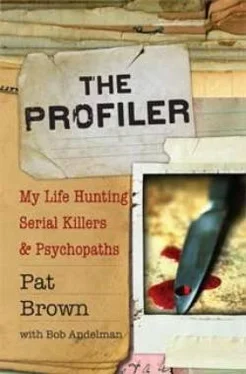Manny took off running with this concept. There were lots of people involved in drugs around the area where Sarah was murdered, so he could theoretically do lots and lots of investigating and collect lots and lots of checks. Somewhere along the way, he decided-and I still don’t understand his decision-making here except to think that it was simply arrogance-that having a profiler agree with him would add fuel to his farce and keep the checks coming. He thought I would replicate his own profile of the crime, a notion that had nothing to do with the evidence but included a large cast of characters for him to track down.
He gave me information about drugs and gangs in the area, thinking I would jump on board with him and inspire the family into thinking he was headed down the right trail. But Manny was a lousy profiler.
I told the family that the murder was a sexual homicide committed by a lone serial killer, not a revenge killing by drug dealers. Manny was not a happy man.
THERE HAD BEEN multiple theories over the years in Sarah’s case. There was the drug dealer approach, and then there was the idea that it was a lesbian crime. I thought that was a most interesting one-not correct, but curious.
This theory suggested that it was a lesbian-on-lesbian killing because women don’t use their hands to strangle and men do. But this is not true. Men use their hands and other methods as well. Apparently, some folks have never heard of a male killing a woman by ligature strangulation, which I thought was amusing, because one of the most common ways that men kill women is exactly that way. The man sneaks up behind the woman and throws a phone cord, a belt, or the cord of a window blind around her neck. Ligature strangulation can be useful in preventing the woman from clawing at your hands, leaving scratch marks on you and getting your DNA under her nails. Women use ligature strangulation for this reason also and because it’s easier than strangling someone with your bare hands, especially more delicate female hands. But in Sarah’s case, it made no sense whatsoever. First, she wasn’t a lesbian. Second, the woman would have had to be one heck of a big, tough broad to do what the killer did to Sarah.
One of the things I always tell the police and families is that while everything is possible, not all things are probable. You can’t waste a lot of investigative effort on an extremely unlikely scenario; you have to stay with what makes sense. If we do get some odd information that proves it might be of interest, yes, of course it should be taken into consideration because you shouldn’t eliminate anything, either. But truly, every possibility is not really worth looking at.
The Andrews case showed me where criminal profiling and crime reconstruction are useful and that police departments often jump over this part of dealing with a homicide. Sometimes it is a matter of lack of training or funds to hire profilers, but a good portion of the time the investigator just doesn’t have hours and hours to spend analyzing one crime when they have new ones showing up daily. He goes with his gut-hopefully, a good one based on years of experience-and, if all goes well, it pans out and the case moves in the right direction.
Police are used to run-of-the-mill homicides, which include most of the homicides many investigators see. One guy pisses off another guy in a bar and gets stabbed. A drug dealer rips off another drug dealer and gets shot. Big deal. They don’t feel sorry for the victim and they don’t have to do much analysis to figure out the crime.
But Sarah Andrews was different. When the police showed up to view the body lying desolately in the empty parking lot behind the nightclub on that cold March morning, their blood ran cold from more than the winter weather. It was a chilling case that likely still lurks in the recesses of the detectives’ memories.
Sarah was found lying on her back, a little bit to her left side-“posed,” according to the police. At a distance, she looked almost artistic, like a Botticelli painting, the way she was lying there, her arms out and her legs bent. Her skin looked like marble against the gray pavement, her hair framing her face, a few dark strands across her eyes. Clumps of white snow seemed to accent the landscape. One could almost see a model lounging for the artist as he put brush to canvas, creating his masterpiece. Unfortunately, instead of being viewed in a portrait gallery, Sarah became part of a crime file, the police photographer snapping his picture methodically.
She was naked except for a shoe on her left foot and the leggings hanging off of it. The double coat hanger was at her mouth and around her neck, and that’s what was used to strangle her. There were bite marks on her breast and hand. She had been sodomized with an object. Her right nipple was missing. It was a gruesome crime.
Sarah’s Maryland driver’s license-which had expired-was lying under her body. I will never know for sure whether the murderer tossed it to the ground along with her to say, “Ha, ha, here’s who this is,” or whether he was sending a message to somebody that he killed Sarah, or maybe he was just being funny, saying, “Look, she’s expired just like her license.”
One of the things you never know with an offender is what’s going through his mind, exactly. Sadly, serial killers and sex offenders are sometimes quite amused by designing their artistic projects. Others couldn’t care less and will simply rape, kill, and drive off. So one of the interesting behaviors in this crime is that the killer left Sarah’s license with her. We will never know why, but we do know that he had access to her license and he left it at the scene.
When you’ve worked in the field a long enough time, there’s little you can see that would make you say, “This is the worst thing I’ve ever seen in my life,” because in homicide investigations, you see so many awful things. It almost becomes a joke, like, “Well, she’s still in one piece. That’s fabulous!” Or “She’s been stabbed sixty times, but her head’s still attached. I think that’s a plus.” This is the way some investigators actually think and talk after being on the job for a while. It’s sad but true. At a mechanic shop where body parts are found scattered about, you might hear if you snuck onto such a scene:
“Do you need a hand over there?”
“I’m not sure we can piece this one together.”
“This guy really doesn’t have a head for business.”
Sometimes the puns just bubble up amid the horror. But, in Sarah’s case, there was likely more workmanlike quiet as the police handled the scene.
As a criminal profiler, I am not looking at the fresh crime scene but at photos, which dulls the incoming sensory stuff quite a bit, so I have a great deal of empathy for the detectives who stood there at the scene and saw this horrific sight firsthand. If a crime involves a drug dealer who was shot, that may not be the worst thing they’ve ever seen. In fact, they might say, “That’s messy, but he deserved it.” Then they walk away and forget it. But if the same investigator sees a child who has been murdered, he might completely lose it, because that, to him, might truly be the worst thing he has ever seen.
Sarah was a beautiful young military recruit, brutally killed and tossed like garbage in a parking lot. It took a great toll on the detectives. They wanted to get the perpetrator, that son of a bitch. They asked questions, did the legwork. They pounded the pavement, just like in the movies, hearing stories, compiling leads. Drug dealing was mentioned and it was implied that maybe Private Sarah Andrews wasn’t the perfect soldier. Theories flew. Maybe Sarah was in the middle of something dirty; maybe a drug dealer retaliated against her for something she said or did-or didn’t do.
Читать дальше












